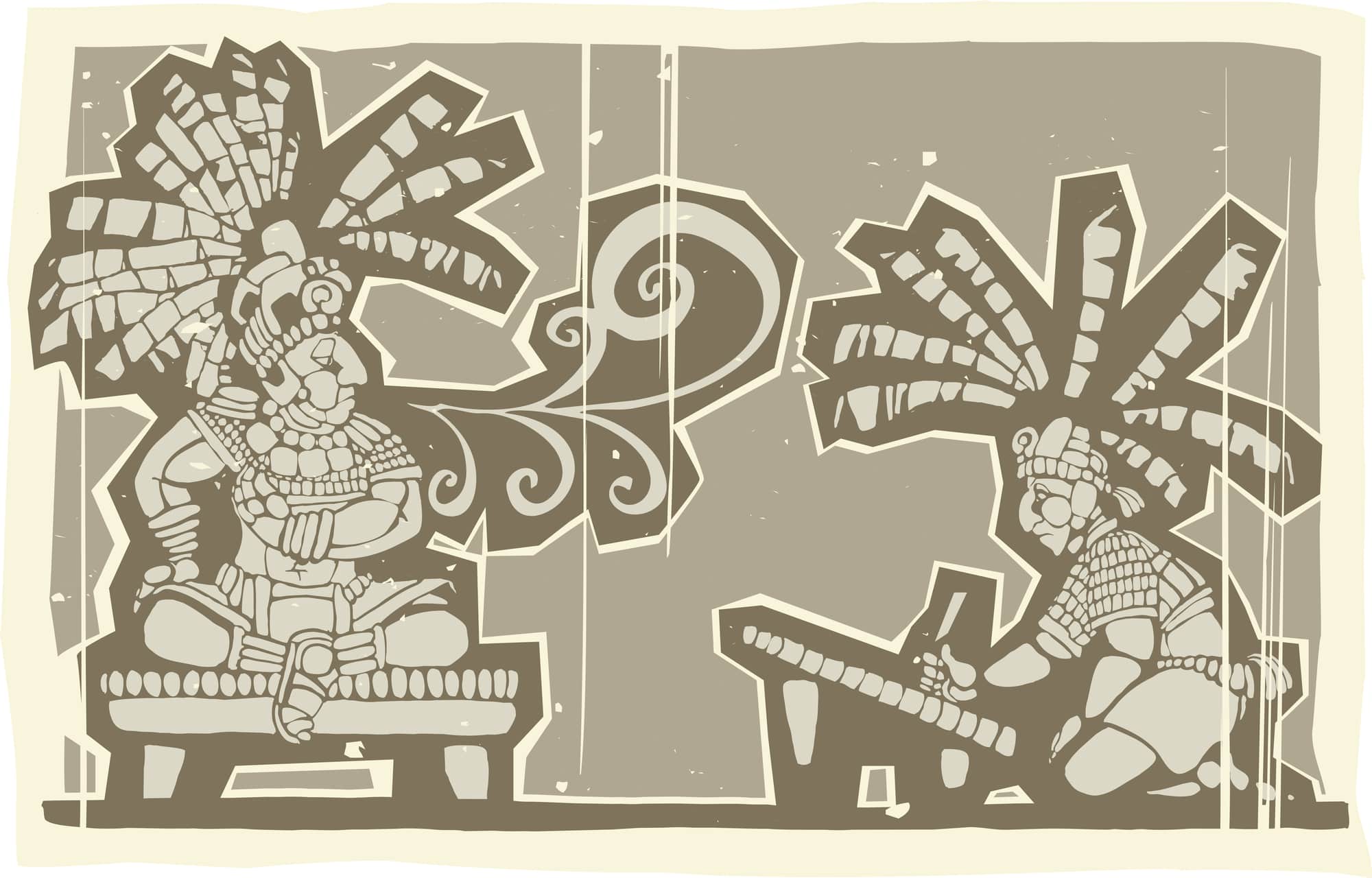The Maya were one of the Indigenous Peoples who lived in the Americas for the longest time. Several centuries before the arrival of Christopher Columbus, they were a dominating civilization. Most of their cities were centered in the Yucatan Peninsula and present-day Guatemala.
Many of their settlements have been discovered in present-day Mexico, Guatemala, Belize, and Honduras. Some of these settlements are more than 3800 years old.
The first Maya were farmers. They grew crops like beans, corn, and cassava. As time progressed, the subsequent generations of these farmers started to expand to other areas near them.
The golden age of the Maya
This expansion continued for centuries, and as a result, in 250A.D, the golden age of the Maya began. By then, the Maya civilization, which started as an agricultural civilization 2000 years ago, had grown to an enormous empire comprising some 40 cities.
Each of these cities had a population ranging from 5,000 to 50,000 people. In addition to that, a large population of farmers lived around each city, who provided the food for its inhabitants. So, at its peak, the population of the Maya Empire could have reached anywhere between 2,000,000 and 10,000,000.
But it is intriguing how these people built such big cities which housed such enormous populations in uninhabitable rain-forests. After all, there weren’t many rivers in the area where they lived. The limestone under the thin layer of soil also absorbed most of the rainwater.
So, they discovered innovative techniques to conserve and effectively manage water. Using this effective water management as the solid foundation, the Maya built a thriving civilization.
Advancements in different fields
But the Maya weren’t just skilled in engineering; they were also skilled in other fields like Mathematics and astronomy. Their use of Zero and their development of complex calendar systems stand testimony to this fact. Some of these calendar systems, like the Calendar round, which the Maya designed based on 365 days, and the Long Count Calendar, which they created to last for 5,125 years, amaze human beings even today.
The Maya were also skilled architects. They used the limestone, which was abundant in this area, to build impressive structures. Excavations from this time have uncovered Maya temples, plazas, palaces, pyramids, and ball courts where they played their famous ball game Ulama.
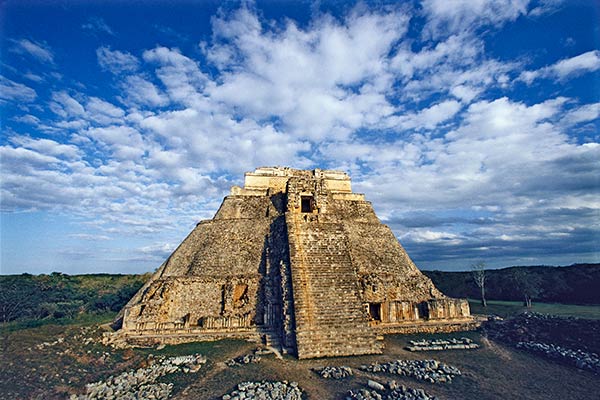
Picture of a Maya Pyramid in Uxmal, Mexico (Picture credits)
But the Maya did not build such buildings just to show off their power and wealth. Each of their buildings held religious or cultural importance in their well-structured, hierarchical society. For example, their pyramids served as temples, tombs, as well as places of religious rituals like human sacrifices.
Wait, what? Religious sacrifices? But why would they do that? Were they barbarians?
Why did the Maya sacrifice humans?
The Maya were very religious. Since many of them were farmers, most of their gods were related to nature and harvest, like the sun god, the moon god, the rain god, and the corn god.
The Maya considered the world as hostile and thought that it was controlled by many unpredictable gods. So, they lived in great respect and fear of these gods. Therefore, they did everything to appease their gods and nourish them. According to the Maya culture, blood was the primary source of nourishment for their gods. And human blood, that too of noble birth, was the most valued. So, they often sacrificed their most valued prisoners of war to their gods during religious rituals. The other prisoners of war were often used as slaves.
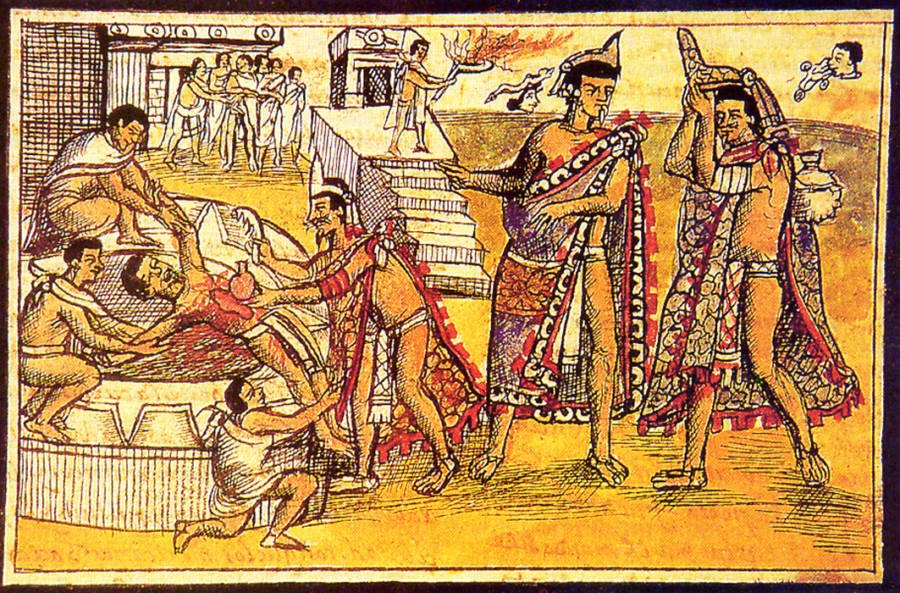
The Maya sacrifice a human to their gods (Picture credits)
You may think that sacrificing someone else to nourish their own gods is a terrible thing to do. But for the Maya, while sacrificing a human was their duty to their gods, being sacrificed was an honor.
The Maya’s concept of underworld and paradise
The Maya believed that there was a dark realm beneath the world called Xibalba (Place of fear). The Tree of Life grew from this dark realm, coming up through the earth and reaching the heavens.
According to the Maya, one did not go to heaven or hell upon death. Instead, the dead person’s soul embarked on a journey, which started in the treacherous underworld (Xibalba). Xibalbans, the beings that lived in this underworld, would try to trick and destroy human souls. But the soul had to evade the Xibalbans and reach the Tree of Life. Then, it had to travel through nine levels of the underworld and thirteen levels of the higher world to finally reach the paradise called Tamoanchan, where beautiful flowers grew.
But there were exceptional cases when a soul could bypass the underworld and reach paradise instantly. These exceptional cases were being killed in warfare or on the ball court, being sacrificed to the gods, committing suicide, or dying in childbirth.
Once the soul reached paradise, it could find eternal happiness. But Maya believed that paradise was not in the sky. Instead, it was a mystical mountain on the earth that was located far, far away. This was the reason why the Maya believed that there was nothing wrong with human sacrifice. Because when people were sacrificed to the gods, they did not die; they simply moved to another place.
This religious belief was central to their culture. So, they regularly held religious rituals. These rituals were held either in dark caves, which symbolized the dark underworld Xibalba, or on high temples and hills, which symbolized the blissful paradise Tamoanchan.
The Maya social structure – the three classes
Next to the gods, the person the Maya revered the most was their king. They believed that their king was related to the gods. So, the Maya respected him greatly and considered him the mediator between the gods and the humans.
The king held supreme authority as the religious, political, and military head of the country. All the other people in the empire fell into one of the three classes – the upper class, the middle class, and the lower class.
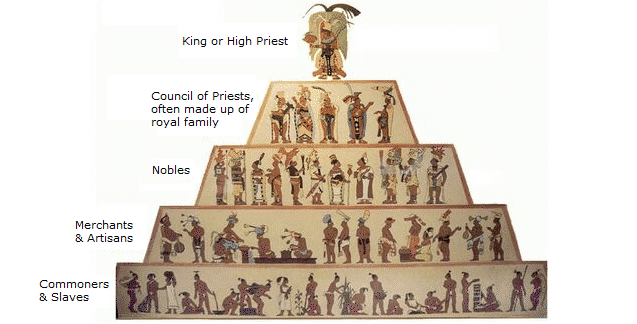
The Maya social structure (Picture credits)
The nobles formed the upper class of the Maya society. They were either the family members of the king or held positions like military leaders, high priests, local administrators, trade leaders, tax collectors, and plantation managers. They were wealthy, literate, and lived in the central part of the city.
People who possessed specific skills, like architects, artists, astronomers, scribes, and warriors, formed the middle class of the society.
Construction workers, farmers, and slaves formed the lower class of society. They lived outside the central part of the city.
To understand how these different classes of people lived, we have to start at the bottom.
How did different people live in the Maya civilization?
How was the daily life of a Maya like? To find this out, we have to look at the different classes of people, how they were treated by the society, and how they lived.

Clay figurines representing (Left to right) a Maya king, priest, costumed nobleman, seated woman, warrior, and commoner.
Slaves
In the Maya culture, people who committed crimes or were considered a burden to society became slaves. This included prisoners of war, citizens who failed to pay debts, and unwanted orphaned children. But unlike the slavery practiced by the Europeans, in Maya culture, slavery was not passed down to their children.
Slaves were at the absolute bottom of the Maya civilization. They worked in the houses of nobles but did not have any rights or privileges. Yet, they were not normally mistreated by their masters because they did all the manual work. They cleaned the nobles’ houses, cared for their children, and worked in their fields. They also built temples and palaces. And despite all their hard work, they were the ones who were mostly used for human sacrifices. In most Maya cities, slaves were also burned when the nobles who owned them died so that they continued to serve their masters in their afterlife.
Commoners
Most of the people in the Maya civilization lived in the lower class as farmers. Since the Maya relied heavily on agriculture for food and trade, most ordinary people worked as farmers.
But the life of a farmer was not easy. The Maya men and boys woke up early and went to farms. The Maya did not have farm animals like oxen or horses to plow the land. So, they did all the work by themselves. Moreover, the Maya did not have any metal tools. All they had were stone tools, like stone axes, which had to be sharpened frequently. Once the farming season was over and the crops were harvested, these farmers worked the rest of the year building pyramids and temples.
Some of the commoners also worked in limestone quarries, and others worked as servants for the nobles.
While the men worked at farms and built temples, the women cooked, cleaned, wove clothes, bred bees, and carried goods from the fields to the markets. The Maya did not use any carts because the use of wheels wasn’t widespread in the Maya civilization. Even though they made toys fitted with wheels, they didn’t use wheels for a practical purpose like making carts. So, the women kept the goods in baskets, placed these baskets on their heads, and walked from the farm to the market.
Thus, whatever jobs the commoners did, their lives involved plenty of hard labor. But that is not to say that life was all work and no play for them. At least once every month, the Maya held a religious festival in their cities. Everyone went to these festivals, where they would eat, sing, dance, worship their gods, and watch ball games.
Merchants
Initially, the Maya civilization consisted of only small villages. So, the farmers and workers in the village could produce enough goods to sustain the population. But as villages grew into small towns and small towns grew into big cities, locally produced goods were not enough to sustain the tens of thousands of people. Moreover, people’s needs got diverse, and hence, food and clothes were not the only things they needed any more. So, trading with other villages and cities became indispensable for Maya cities. Hence, merchants played an important role in the Maya civilization.
The Maya merchants traded two different kinds of goods – useful commodities and luxury items. Useful commodities were items people used every day, like food, clothes, tools, etc. Luxury items were items that the nobles used to portray their wealth, like gold, jade, feather works, jewelry, etc.
Big cities had market centers where the local Maya people could exchange the goods they produced for products like feathers, jade, etc. Villages and small towns which did not have exclusive market centers had market days when people aggregated and exchanged goods.
Useful commodities like food were traded locally in such markets. Food that was not readily available was obtained by trading with nearby cities. Luxury items, on the other hand, were not easy to obtain. So, merchants traveled long distances to procure them. The trade routes that the Maya merchants established reached up to the Caribbean islands and even South America.
Currency
But despite trade being an important part of their civilization, the Maya did not have a form of currency. They traded using the Barter system, by exchanging goods they had an excess of for goods they lacked. But as one would expect, all things were not traded at the same ratio. Luxury items, in particular, had more value. For example, one pound of Cocoa was exchanged for two pounds of corn. Gold was costlier and was traded for 20 pounds of corn. The feathers of Quetzal, a colorful bird that lives in Central America, were even costlier and would fetch 50 pounds of corn.
But according to recent research, the Maya might have actually started using cocoa beans and woven clothes as forms of currencies as early as the Seventh Century.
Artisans
The Maya Artisans included people who worked on feathers, crafted jewels by hand, sculpted stone statues, or made pots. Just like the merchants, they were necessary for big cities to meet the varied needs of their people.
The lives of artisans were a little bit easier than that of farmers because they didn’t have to do as much hard labor as lower-class people. But even though they didn’t have to do hard labor, they still woke up early every day to do their jobs. Their profession was passed down from father to son. So, big families lived together under one roof and practiced one profession.
The artisans made more money than the farmers. So, they used the money left after paying taxes and tribute to improve their lives, like buying better food, clothes, and jewelry.
Warriors
For several years, historians believed that the Maya were peaceful people. Even though they used their captives as slaves and human sacrifices, they didn’t wage wars frequently. But recent archaeological findings suggest that the Maya kings wanted more land and natural resources and have greater control over trade networks. So, from 600AD to 900AD, Maya city-states were in a constant state of war.
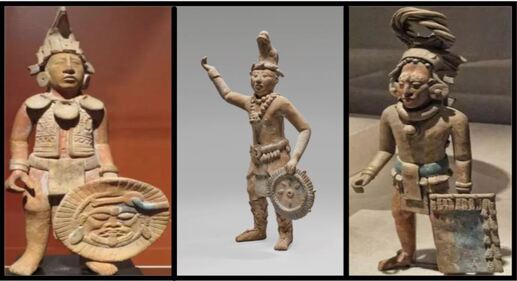
Clay figures of Warriors
So, warriors became prized possessions of city-states and were highly respected. The Maya warriors prepared for battle in a unique way. First, they made a shield and painted all the battles they had won and all the things they had established on it. Then, they danced together, holding their shields while the noisemakers made noises to boost their confidence.
The Maya used many weapons. This included long-range weapons like slings, spears, arrows, as well as short-range weapons like clubs, knives, and axes. But whenever possible, the Maya tried not to kill their opponents so that they can use them later as slaves and human sacrifices.
Nobles
The nobles were the people who had royal blood but were not the king. They formed the smallest part of the Maya society but possessed great wealth and power. They performed the most important jobs in the city – priests, tax collectors, government officials, etc.
According to Maya culture, the nobles were holy people whose existence bordered between gods and humans. So, they enjoyed better material benefits. They ate more meat and drank a chocolate drink every day. They wore fancy clothes and jewelry. But in exchange, they made sacrifices to gods, including their own blood. They pierced their ears or tongue with a thorn, squeezed the blood on a piece of paper, and burned them. They considered it an honor to do so.
Priests
As we saw above, the Maya were highly religious people. So, the priests enjoyed great respect, considered second only to the kings in the societal structure.
The Maya priests were the most educated of all the Maya people. They had several duties.
Their foremost duty was to advise the kings on when to wage wars, and when to plant crops using the Maya Calendar, and their knowledge of astronomy and astrology. Another important duty of these priests was to teach the sons of nobles. They also hosted religious ceremonies. During these ceremonies, they talked to the gods and interpreted their will.
The King
The person at the very top of the Maya society was the king. Since the king was considered a descendant of the gods, his authority was absolute. But the Maya Empire did not have one supreme king. The Maya Empire had several city-states, which were ruled by different royal families. But a king still ruled over a vast city. Moreover, large cities controlled the smaller ones near them and received tributes from these smaller cities.
The Maya king was selected by a council of Batabs, who also kept a check on his power.
The Batabs were local administrators of individual towns or villages. Their tasks were to provide troops for war and to ensure that people paid their tributes. The king was initially selected by the Batabs from among themselves.
But once selected, the king followed a hereditary succession. The ruling authority passed down from father to son. If the king had no heir, the Batabs got together and chose their next king. But that incident very rarely happened. So, in reality, the same family might rule the city forever until people believed that the ruler had lost the favor of the gods. Losing at war was a definitive sign for the Maya that their king had lost the favor of the gods.
The Maya’s decline
Thus, supported by their societal structure, the Maya Empire flourished greatly from the third century to the ninth century. Their Empire covered almost one-third of Mesoamerica. However, in the ninth century, Maya abandoned the city-states and moved north. Thus, the Maya Empire, which dominated Central America, collapsed. Nobody knows why it happened. But there are some guesses.
Possible causes
During the golden age of the Maya Empire, the population of their city-states increased rapidly. So, Maya could have over-exploited the natural resources and degraded their environment to feed their overpopulated cities. As a result, by the ninth century, their yields could have dropped significantly. So, without enough food to support huge populations, people might have abandoned the city-states.
The frequent wars among neighboring city-states could have also deemed the cities unsafe. So, people might have abandoned them.
Severe drought could have occurred that left large populations starving. So, they might have moved north searching for better opportunities.
But historians believe that a combination of these factors might have led to the collapse of the Maya Empire. Thus, by the ninth century, the Maya city-states, which had housed tens of thousands of people over hundreds of years, became deserted. Only a handful of city-states, like the Chichen Itza, remained. These cities, too, fell in the eleventh century. Then, the Maya lacked a strong power until Mayapan rose as a prominent city in the twelfth century. At its peak, 14,000 to 17,000 people lived in this city. But this city, too, like its predecessors, fell in the fifteenth century.
As a result, by the time Spanish explorers reached Central America, the remnants of the Maya Empire were rebuilding. But they never got to do that since the Spanish conquest decimated them.
Some fun facts and myths about the Maya
1. Where did they get their name from?
The Maya did not call themselves Maya. The term Maya comes from the ancient city Mayapan, the last capital of the Maya kingdom before the Spanish arrival. The ancient Maya lived in separate city-states. These cities did not have political unity, and their citizens did not share a sense of common identity. The Maya who lived in different city-states did not consider themselves inhabitants of different states of a big empire. Instead, they considered themselves as citizens of different countries.
2.How did they justify human sacrifices?
The Maya did not sacrifice humans for the fun of it. They sacrificed humans to nourish their gods. Being sacrificed to the gods was also considered an honor because it was one of the few ways a soul could reach paradise directly, without suffering in the underworld.
3. Did they really sacrifice the losers of their ball-game?
The Maya might not have sacrificed their ball-game players. The Maya ball game called Poc-a-Toc was deeply meaningful to them. It was not just a spectator sport. It is a game where two teams of seven faced off each other on a ball court. The walls of the court sloped inward, and there were stone rings high on the walls.
The ball represented the sun and the moon, and the court represented the earth. Just as the sun and the moon never touch the earth, the ball should also be kept in the air. So, the game ended when the ball touched the ground or when a player put the ball through one of these rings. The ball had a diameter of 50cm, and the players cannot use their hands or legs. They can only use their heads, shoulders, hips, and knees to pass the ball.
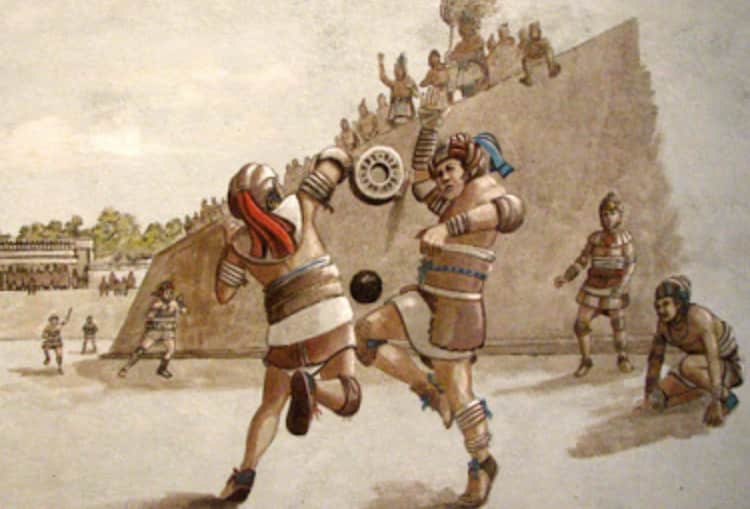
The Maya ball game (Picture credits)
So, the game was extremely difficult to play. Indeed, in most cases, the game ended when one of the teams put the ball through the ring. Until recently, two theories about the ball game existed. According to one theory, Poc-a-Toc was a game of survival, i.e., the losers were often sacrificed to the gods. According to a more recent theory, only the winning team’s captain was sacrificed because being sacrificed was considered an honor.
A contradicting belief – To believe or Not to believe?
But according to Christophe Helmke, an associate professor at the Institute of Cross-Cultural and Regional Studies at the University of Copenhagen, neither of these theories might be true. He says that the ball games might have just been what they were – games. The players might not have been sacrificed after all. If the best players were always sacrificed, it would have been terrible for the game. Even in games where humans were sacrificed, the players might not have been sacrificed. The person who was sacrificed could have been someone else, who would have been sacrificed even if the game wasn’t played.
According to him, the misconception could have stemmed from the epic that tells the story of the creation of the Maya people. According to this myth, the deities of the underworld once played a ball game against humans. They used trickery in that game to win against humans and then decapitate them. Annoyed, the twin sons of one of the decapitated humans played against the underworld deities, won against them, and then dismembered them.
So, the artwork found on the ball courts might actually be a reference to this creation myth. Therefore, maybe we shouldn’t take it too literally. But, we cannot know for sure what happened several centuries ago.
4. Did they really predict when the world would end?
The Maya did not predict that the world would end on 21-12-2012. In the Maya calendar system, two calendars were at work simultaneously. One of these was the Haab, the civil calendar, which had 365 days. The other calendar was the Tzolkin, the sacred calendar, which had 260 days. Both these calendars work together but can account only for dates up to 52 days in the future.
For longer calculations, they used the Long Count calendar, which accounts for 5,125.36 years. The Maya considered this period the Great cycle. Since the long count calendar began on 11.08.3114 BC, it had to end on 21.12.2012 AD. Many people wrongly believed that the Maya actually predicted that the world would end on this date. But it is not true. Indeed, according to the Maya, the 5125 years of the Long Count Calendar just represents one cycle, the Baktun. The end of one Baktun doesn’t mark the end of the world but the start of another Baktun.
Where do the Maya live today?
Despite all the horrible things they had to go through, the Maya were not completely wiped out. Today, their descendants can be found in Central America, the majority of them living in Guatemala. The rest live in other Central American countries like Mexico, El Salvador, Belize, and Honduras.
